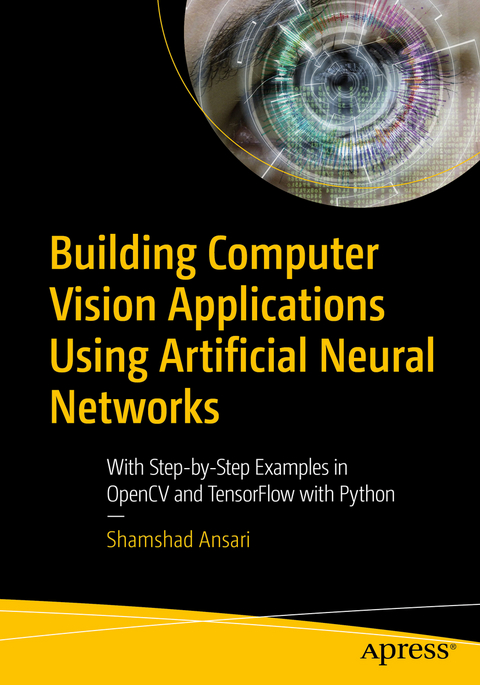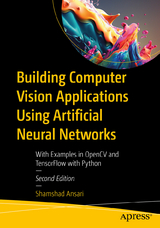
Building Computer Vision Applications Using Artificial Neural Networks
Apress (Verlag)
978-1-4842-5886-6 (ISBN)
- Titel erscheint in neuer Auflage
- Artikel merken
The book comprises four main sections starting with setting up your programming environment and configuring your computer with all the prerequisites to run the code examples. Section 1 covers the basics of image and video processing with code examples of how to manipulate and extract useful information from the images. You will mainly use OpenCV with Python to work with examples in this section.
Section 2 describes machine learning and neural network concepts as applied to computer vision. You will learn different algorithms of the neural network, such as convolutional neural network (CNN), region-based convolutional neural network (R-CNN), and YOLO. In this section, you will also learn how to train, tune, and manage neural networks for computer vision. Section 3 provides step-by-step examples of developing business and industrial applications, such as facial recognition in video surveillance and surface defect detection in manufacturing.
The final section is about training neural networks involving a large number of images on cloud infrastructure, such as Amazon AWS, Google Cloud Platform, and Microsoft Azure. It walks you through the process of training distributed neural networks for computer vision on GPU-based cloud infrastructure. By the time you finish reading Building Computer Vision Applications Using Artificial Neural Networks and working through the code examples, you will have developed some real-world use cases of computer vision with deep learning.
What You Will Learn
· Employ image processing, manipulation, and feature extraction techniques
· Work with various deep learning algorithms for computer vision
· Train, manage, and tune hyperparameters of CNNs and object detection models, such as R-CNN, SSD, and YOLO
· Build neural network models using Keras and TensorFlow
· Discover best practices when implementing computer vision applications in business and industry
· Train distributed models on GPU-based cloud infrastructure
Who This Book Is For
Data scientists, analysts, and machine learning and software engineering professionals with Python programming knowledge.
Shamshad (Sam) Ansari works as President and CEO of Accure Inc, an artificial intelligence automation company that he founded. He has raised Accure from startup to a sustainable business by building a winning team and acquiring customers from across the globe. He has technical expertise in the area of computer vision, machine learning, AI, cognitive science, NLP, and big data. He architected, designed, and developed the Momentum platform that automates AI solution development. He is an inventor and has four US patents in the area of AI and cognitive computing. Shamshad worked as a senior software engineer with IBM, VP of engineering with Orbit Solutions, and as principal architect and director of engineering with Apixio.
Section 11.Chapter 1: Prerequisite and Software Installation1.1.Python and PIP1.1.1.Installing Python and PIP on Ubuntu1.1.2.Installing Python and PIP on Mac OS1.1.3.Installing Python and PIP on CentOS 71.1.4.Installing Python and PIP on Windows1.2.Virtualenv1.2.1.Setup and activate virtualenv1.3.Tensorflow1.3.1.Installing Tensorflow1.4.PyCharm IDE1.4.1.Installing PyCharm1.4.2.Configuring PyCharm to use virtualenv1.5.OpenCV1.5.1.Installing OpenCV1.5.2.Installing OpenCV4 with Python bindings1.6.Additional libraries1.6.1.SciPy1.6.2.Matplotlib
Chapter 2: Core Concepts of Image and Video Processing1.7.Image processing1.7.1.Image basics1.7.2.Pixel1.7.3.Pixel color1.7.3.1.Grayscale1.7.3.2.Color1.7.4.Coordinate system1.7.5.Python and OpenCV code to manipulate images1.7.6.Program: loading, exploring and showing image1.7.7.Program: OpenCV code to access and manipulate pixels1.8.Drawing1.8.1.Drawing a line on an image1.8.2.Drawing a rectangle on an image1.8.3.Drawing a circle on an image1.9.Chapter summary1.10.2.Chapter 3: Techniques of Image Processing2.1.Transformation2.1.1.Resizing2.1.2.Translation2.1.3.Rotation2.1.4.Flipping2.1.5.Cropping2.2.Image arithmetic and bitwise operations2.2.1.Addition2.2.2.Subtraction2.2.3.Bitwise operations2.2.3.1.OR2.2.3.2.AND2.2.3.3.NOT2.2.3.4.XOR2.3.Masking2.4.Splitting and merging channels2.5.Smoothing and blurring2.6.Thresholding2.7.Gradient and edge detection2.8.Contours2.9.Chapter summary
Section 23.Chapter 4: Building Artificial Intelligence System For Computer Vision3.1.Image processing pipeline3.2.Feature extraction3.2.1.Color histogram3.2.2.GLCM3.2.3.HOG3.2.4.LBP3.3.Feature selection3.3.1.Filter3.3.2.Wrapper3.3.3.Embedded3.3.4.Regularization3.4.Chapter summary
4.Chapter 5: Artificial Neural Network for Computer Vision4.1.Introduction to ANN4.1.1.ANN topology4.1.2.Hyperparameters4.1.3.ANN model training using TensorFlow4.1.4.Model evaluation4.1.5.Model deployment4.1.6.Use of trained model4.2.Introduction to Convolution Neural Network (CNN)4.2.1.Core concepts of CNN4.2.2.Creating training set for CNN4.2.3.Training CNN model using TensorFlow 4.2.4.Inspecting CNN model and evaluating model fitness4.2.5.Using and deployment of trained model4.3.Introduction to Recurrent Neural Network (RNN) and long short-term Memory (LSTM)4.3.1.Core concepts of RNN and LSTM4.3.2.Creating training set for LSTM4.3.3.LSTM model training using TensorFlow4.3.4.Inspecting LSTM model and assessing fitness4.3.5.Deploying LSTM models in practice
Section 35.Chapter 6: Practical Example 1- Object Detection in Images6.Chapter 7: Practical Example 2- Object Tracking in Videos7.Chapter 8: Practical Example 3- Facial Detection8.Chapter 9: Industrial Application - Realtime Defect Detection in Industrial Manufacturing
Section 49.Chapter 10: Training Machine Learning Model on the Cloud9.1.Amazon AWS9.2.Google Cloud Platform (GCP)9.3.Microsoft Azure
| Erscheinungsdatum | 30.07.2020 |
|---|---|
| Zusatzinfo | 201 Illustrations, color; 46 Illustrations, black and white; XXII, 451 p. 247 illus., 201 illus. in color. |
| Verlagsort | Berkley |
| Sprache | englisch |
| Maße | 178 x 254 mm |
| Gewicht | 898 g |
| Themenwelt | Mathematik / Informatik ► Informatik ► Programmiersprachen / -werkzeuge |
| Informatik ► Theorie / Studium ► Künstliche Intelligenz / Robotik | |
| Schlagworte | Artificial Intelligence • computer vision • convolutional neural network • Deep learning • machine learning • neural network • OpenCV • Python • Recurrent Neural Network • tensorflow |
| ISBN-10 | 1-4842-5886-X / 148425886X |
| ISBN-13 | 978-1-4842-5886-6 / 9781484258866 |
| Zustand | Neuware |
| Informationen gemäß Produktsicherheitsverordnung (GPSR) | |
| Haben Sie eine Frage zum Produkt? |
aus dem Bereich



